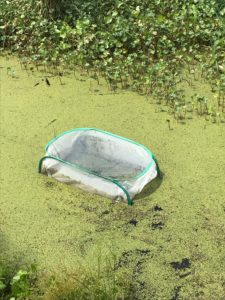Research from scientists at the University of Georgia revealed that changes in the environment can alter the reliability of a tool widely used to monitor heavy metal contamination in aquatic systems.
Diffusive gradients in thin film, known as DGT, has been viewed as an advanced, reliable tool for nearly three decades, facilitating compliance with government regulations that protect ecosystems and human health.
But during a summer trial, DGTs failed to indicate bioaccumulation of copper and zinc in a constructed wetland because of increased rainfall, according to Xiaoyu Xu, an assistant research scientist at the Savannah River Ecology Laboratory.
The research was conducted in a wetland that reduces the concentrations of metals received from discharge waters from a production facility on the U.S. Department of Energy’s Savannah River Site near Aiken, South Carolina.

When Xu and her team repeated the trial during the winter with the same parameters, the DGTs accumulated the metals and performed equally with the traditional biomonitoring method that was used—live organisms.
During both 12-day trials, freshwater mussels were placed in the wetland with the DGTs to compare the performance of each in accumulating the metals.
“Mussels are widely used around the world as bioindicators in metal biomonitoring programs because their abundance makes them easy to attain, and they quickly accumulate metals from the ambient environment,” said Xu, a biochemist.
But DGTs are much more efficient for monitoring metal contamination than using organisms, according to Xu.
“Collecting organisms in the field is costly and time consuming,” she said. “It requires catching a decent sample size of the same species and distributing them equally by age and sex in the study area.”
According to the study, published in the journal of Environmental Toxicology and Chemistry, the DGTs failed in the summer as a result of increased rainfall.
“An extensive dry period before the heavy rainfall resulted in metals accumulating in the retention basin of the wetland,” Xu said. “When the storms came, the flow of muddy waters altered the concentration and changed the metals to a larger form.”
Xu said DGT is a promising surrogate for biomonitoring, but because unstable water will always change water chemistry in an environment, researchers need to be cautious and selective when they use the DGT.
“Sometimes a combination of techniques may achieve better understanding of metal speciation or form and the risk of toxicity to plants, fish and other organisms,” she said. “Different monitoring techniques need to be thoroughly explored for each system and the data carefully interpreted. This can facilitate the appropriate use of monitoring tools in establishing environmental regulations.”
Additional authors on the study are Erin Peck, Dean Fletcher, Alexis Korotasz, and John Perry, Savannah River Ecology Laboratory, Aiken, South Carolina.






